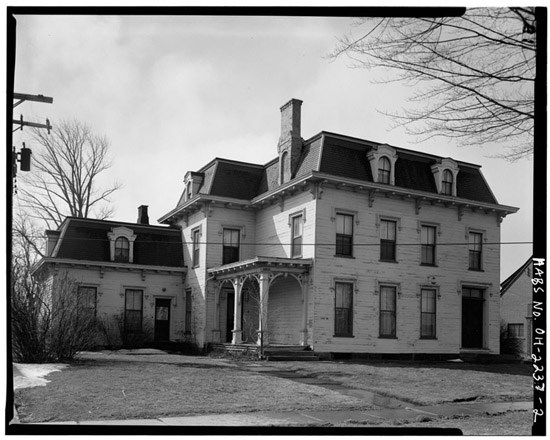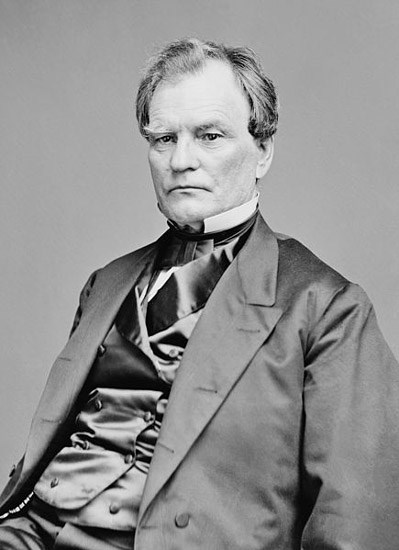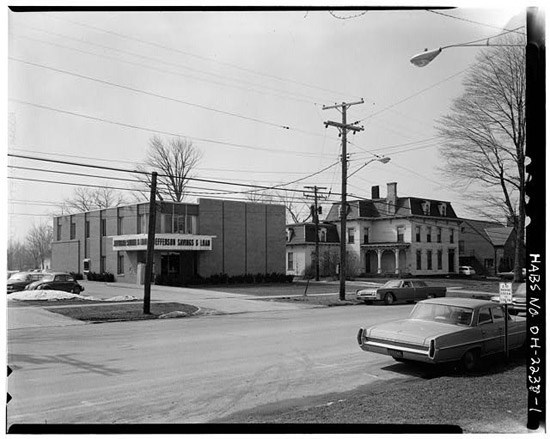
NPS Photo / HABS, courtesy of Library of Congress
Benjamin F. Wade Home
Jefferson, OH
Designated an NHL: December 21, 1965
Designation withdrawn: 1968/70*
*A formal dedesignation process was created in 1980. Before then, a property that no longer met NHL criteria was simply removed from the official list.
Benjamin F. Wade (1800-78) was noted as a forceful and uncompromising politician and legislator, known especially for leading the Committee on the Conduct of the War during the Civil War and the Radical Republican opposition to Presidents Abraham Lincoln and Andrew Johnson. Had Johnson been convicted during his 1868 impeachment, Wade (as president pro tem of the Senate) would have become president.
Born in Massachusetts, Wade's family moved to Ohio when he was 21. He was admitted to the bar in 1827 or 1828 and was elected to the Ohio Senate in 1837. Ten years later, he became presiding judge of Ohio's third judicial circuit, where his dynamic personality and methods attracted attention. The Whig majority in the Ohio legislature applauded Wade's judicial style and elected him to the United States Senate in 1851.
For his era, Wade was a radical. He crusaded for the abolition of slavery, advocated for the vote for women, and attacked the exploitation of labor. Soon after his arrival in Washington, DC, Wade won a position of prominence in the Senate and became a leader of those opposed to slavery. He availed himself of every opportunity to denounce the institution. When the Kansas-Nebraska Act was passed in 1854, Wade, incensed at the expansion of slavery, left the Whig Party and helped to organize the Republican Party in Ohio. He quickly assumed a dominant position in the new party.
The victory of the Republicans in 1860 helped ignite the Civil War and raised Wade to the peak of his career. Wade opposed and criticized Lincoln's leadership from the Battle of Bull Run in 1861 until the president's death in 1865. Through his role as chairman of the Committee on the Conduct of the War, Wade exerted constant pressure on Lincoln for more decisive leadership in the conflict. Wade also vigorously denounced the president's plan for reconstruction, which appeared on December 8, 1863. Wade and a colleague, Henry Winter Davis, proposed a different plan in the Wade-Davis Bill, which the president pocket vetoed on July 8, 1864. Furious and indignant, Wade joined Davis in issuing the Wade-Davis Manifesto, a bitter attack on Lincoln that angered many and, in the long run, hurt Wade's career.

NPS Photo
Upon Andrew Johnson's accession to the presidency, Wade remained obdurate in his hatred for the South and opposition to the executive. Wade was elected president pro tem of the Senate on March 4, 1867, but in the fall of the same year suffered a political blow when the Democrats won control of the Ohio legislature. That meant he would not be reelected to the U.S. Senate in 1869. However, with the impeachment of President Johnson on February 24, 1869, Wade stood the chance of becoming president. His vote for Johnson's conviction, on Saturday, May 16, was part of the minority and Johnson remained in office. Soon after, Wade's power and position declined rapidly. Wade retired from the U.S. Senate. He returned to his law practice and house in Jefferson, Ohio. The Wade house, which likely dated from the time of the Civil War, was a two-story clapboard structure with a Mansard roof.
At the time of its NHL designation in 1965, the Wade house was owned by the Jefferson Savings and Loan Company. The bank offered the house to a local historical society, but the society refused the proffered gift because it could not afford to have the house moved. In January 1968, the Jefferson Savings and Loan Company contacted the Ohio Historical Society with the news that the house would be demolished unless a plan for saving the property could be devised within a short time. No such plan came to fruition.

NPS Photo / HABS, courtesy of Library of Congress
In February 1968, the Historic American Buildings Survey photographed the house. The Benjamin F. Wade Home was demolished that summer. The house's lot was later used as a parking lot for the Jefferson Savings and Loan Company. At the end of August 1968, National Park Service staff took note of the house's destruction.
Last updated: August 29, 2018
